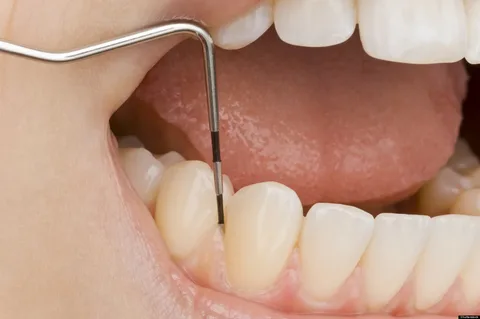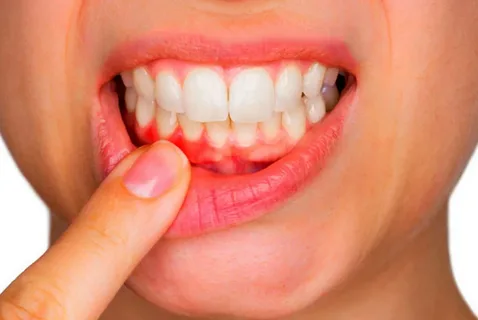Symptomatic periodontitis as a manifestation of systemic diseases
Symptomatic periodontitis is a collective term that unites a group of periodontal tissue diseases that are characterized by pathological disorders in the tissues surrounding the tooth and are a symptom of various general diseases.
The cause of the development of periodontal diseases, according to the modern concept, includes hereditary and acquired conditions, which include all kinds of general diseases of the body. Thanks to clinical and epidemiological studies conducted by different groups of scientists at different times, it was possible to prove the mutual influence of systemic pathology and periodontal diseases.
More relevant information in the section Online courses, lessons and webinars on Periodontology .
Making a diagnosis, drawing up a treatment plan and planning the necessary therapeutic procedures for periodontal diseases against the background of general pathology is impossible without the appropriate professional skills and cooperation with specialists.

Rice. 1. Generalized periodontitis.
Systemic diseases against which symptomatic periodontitis most often develops:
- endocrine disorders,
- pathology of the cardiovascular system,
- diseases of the respiratory and circulatory systems,
- osteoporosis,
- genetically determined diseases.
Symptomatic periodontitis in diabetes mellitus
The prevalence of diabetes mellitus among the population has only increased over the years. This pathology is the third most common cause of death in patients after cancer and heart disease.
The severity of symptomatic periodontitis is largely determined by the type of diabetes mellitus the patient has.
- Type 1 diabetes, also known as insulin-dependent diabetes, is characterized by a rapid increase in symptoms; it is most often diagnosed at a young age, more than half of patients are children.
- Type 2 diabetes, non-insulin dependent, is characterized by a slow increase in symptoms and is first diagnosed in patients aged 45-50 years and older.
The vast majority of patients with diabetes of any type show signs of symptomatic periodontitis, and if this disease is accompanied by a risk factor such as smoking, then the risk of developing severe periodontitis, accompanied by destruction of the tissues surrounding the tooth, increases tenfold.

Rice. 2. Probing of pathological dental-gingival pockets.
The most common manifestations of symptomatic periodontitis in diabetes mellitus are as follows:
- edentia,
- diseases of the oral mucosa,
- gingivitis,
- periodontitis,
- gum hyperplasia,
- tendency to abscess formation,
- vertical type of bone resorption.
The pathogenetic mechanisms characteristic of symptomatic periodontitis in diabetes mellitus are as follows:
- Reduced resistance of periodontal tissues to pathogenic microorganisms due to disruption of the polymorphonuclear leukocyte system.
- Destruction of collagen and disruption of its renewal processes.
- Periodontal tissues lose their ability to regenerate as a result of microvascular lesions that cause metabolic disorders.
- The composition of the microflora of the gingival sulcus changes against the background of thickening of saliva, an increase in the concentration of glucose in it, a change in pH towards an acidic environment, and a decrease in the content of lysozyme.
- The risk of osteopenia increases sharply: an increase in bone resorption processes against the background of high glucose concentrations, a slowdown in bone tissue metabolism due to degradation of the blood supply.
According to biochemical studies, all previously described symptoms and pathogenetic mechanisms directly depend on the concentration of glucose in the patient’s blood and the quality of glucose control. If the patient monitors his health and controls glucose levels, the risk of symptomatic periodontitis and increased complications is significantly reduced.
Optimal principles for the prevention of periodontal complications in diabetes mellitus:
- blood glucose control,
- adequate oral hygiene,
- preventive visits to the dentist.
Symptomatic periodontitis in Papillon–Lefevre syndrome
This syndrome is a hereditary disease and is accompanied by the development of generalized juvenile periodontitis.
Symptoms
- hyperkeratotic skin changes,
- severe form of periodontitis,
- neuroendocrine and metabolic changes.

Rice. 3. Gum recession.
General characteristics of the development of pathology
- The first symptoms of skin and periodontal disorders are detected at the age of 3-4 years.
- At the first stage, hyperkeratosis and ichthyosis of the feet, knees, palms and elbows appear.
- Severe gingivitis is observed immediately after the first temporary teeth erupt; they quickly become mobile, periodontal pockets form, and exudation is noted.
- X-ray images reveal the vertical type of bone tissue destruction.
- By the age of 6, primary teeth fall out. Against the background of the absence of teeth, inflammatory phenomena in periodontal tissues disappear.
- As permanent teeth begin to erupt, the process repeats; by the age of 15, the patient loses all his teeth.
- Dystrophic-inflammatory disorders in periodontal tissues cease only after the final loss of alveolar bone, the progression of the disease stops, and the jaw bone is not subject to destruction.
Symptomatic periodontitis in Down syndrome
This syndrome is a genetic disease, accompanied by generalized juvenile periodontitis, growth retardation, and mental retardation.
The following symptoms are characteristic of the oral cavity:
- macroglossia,
- microdontia,
- folded tongue.
Manifestations of symptomatic periodontitis
- deep pockets,
- moderate or severe gingivitis,
- a significant amount of dental plaque,
- the process is generalized, with a predominance in the frontal area of the lower jaw,
- gum recession,
- rapid progression
- frequent necrotic lesions.
If the patient follows the doctor’s recommendations and begins a well-chosen complex treatment in a timely manner, stabilization of the process is possible.
Symptomatic periodontitis in acquired immunodeficiency syndrome
More than half of HIV-infected patients have periodontal tissue diseases related to symptomatic periodontitis. It is important to note that very often the first signs of HIV infection are observed in the oral cavity.

Rice. 4. Examination of a patient with signs of periodontitis.
The most common manifestations of HIV infection in the oral cavity:
- hairy leukoplakia,
- Kaposi's sarcoma,
- candidiasis,
- atypical periodontitis,
- viral infections.
The sequence of damage to periodontal tissues:
- ulcerative-necrotizing gingivitis,
- hyperemia and bleeding gums,
- rapidly progressive periodontitis,
- generalized uneven bone resorption,
- necrosis and sequestration of bone.
Symptomatic periodontitis with osteoporosis
In the structure of morbidity, osteoporosis ranks fourth after oncology, heart disease and endocrine system diseases. The vast majority of patients are women aged 50 years and older.
Osteoporosis is a metabolic disorder of the skeleton, which is accompanied by a decrease in bone mass and disruption of bone structure, which causes increased bone fragility and the risk of fractures.

Rice. 5. Bleeding gums.
Risk factors for osteoporosis
- floor,
- age,
- lack of sex hormones,
- taking glucocorticoids for a long time and in high doses,
- heredity,
- physical inactivity.
Symptoms
- Slow development.
- General weakness.
- Fast fatiguability.
- Aching pain in the joints and along the spinal column.
- As calcium is “washed out” from the bones, changes in the autonomic nervous system increase.
- Compression fractures of the spine cause changes in posture: decreased height, kyphosis, scoliosis.
Prevention of osteoporosis involves the following measures:
- proper nutrition, the obligatory presence in the diet of foods containing a lot of calcium, phosphorus, other microelements and vitamins;
- playing sports;
- ultraviolet irradiation in small quantities throughout the year to maintain the production of vitamin D3;
- reducing the role of risk factors.
Often, periodontal bone loss is the very first manifestation of osteoporotic disorders in the human body. Many researchers suggest that bone with signs of osteoporosis is more susceptible to lysis under the influence of an infection typical of periodontitis. This hypothesis was confirmed in laboratory conditions when studying osteoporosis in animals. It turned out that osteoporosis, while not being the cause of periodontal resorption, can aggravate the progression of destruction of bone structures and lysis of bone tissue. Studies have shown that patients suffering from osteoporosis are more likely to experience severe forms of periodontal disease and early tooth loss.
Find even more detailed and interesting information on various sections of dentistry on our website .

Article
Luis Felipe Schneider
12 July 2023

Article
Luciano Pitzurra
21 May 2023

Article
Luciano Pitzurra
18 May 2023


